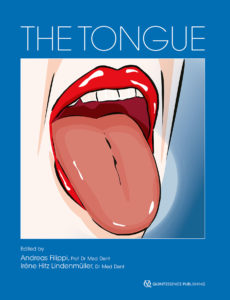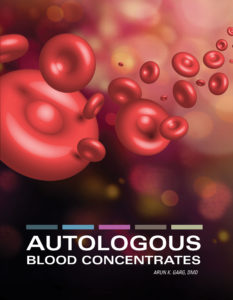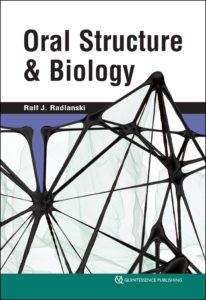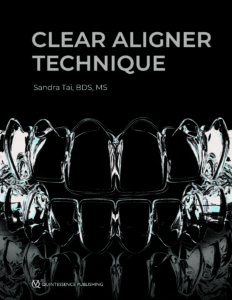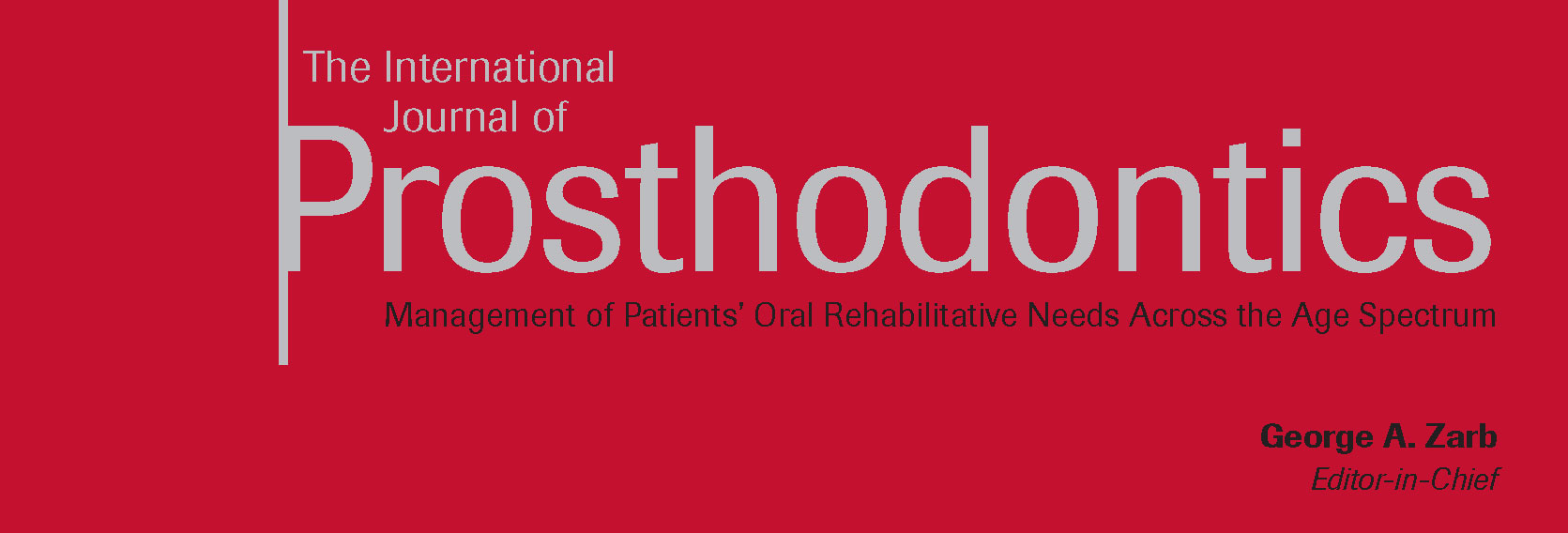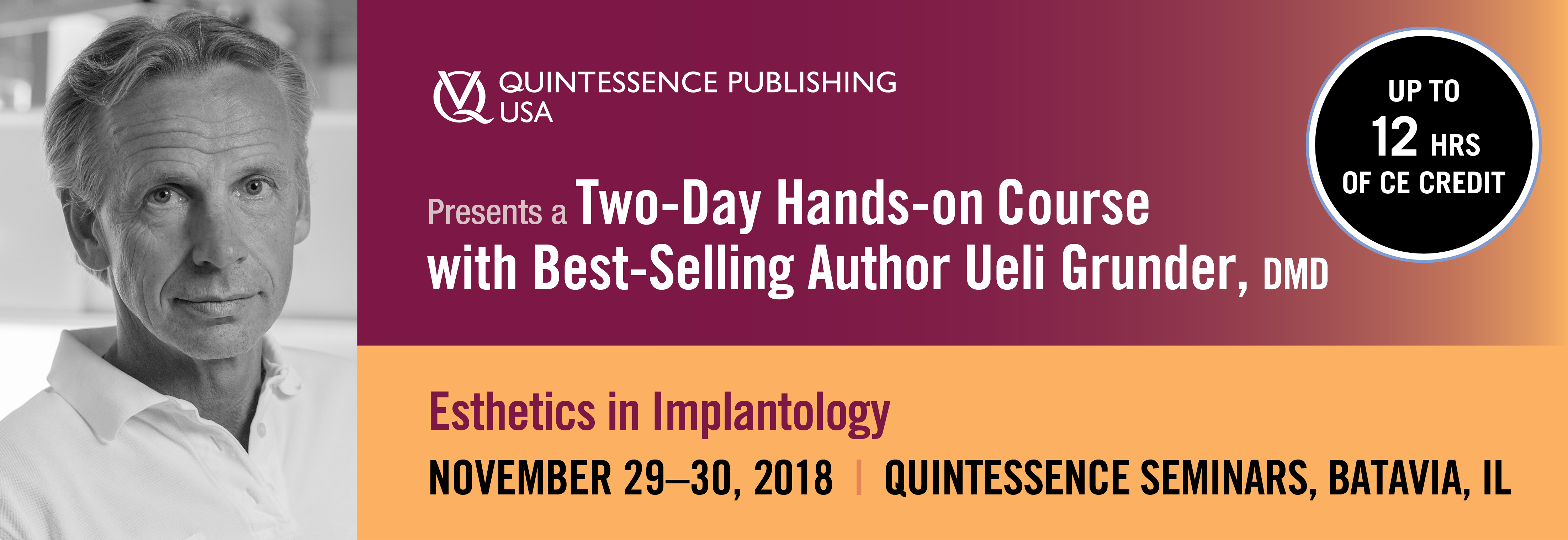October Monthly Special
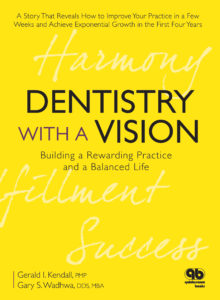 Dentistry with a Vision: Building a Rewarding Practice and a Balanced Life
Dentistry with a Vision: Building a Rewarding Practice and a Balanced Life
Gerald I. Kendall and Gary S. Wadhwa
Dental practitioners and their staff will find this engaging story an easy and fun way to learn how to implement powerful, scientifically based project-management principles into their practice. It will help you to identify the few key issues that are holding you back; substantially increase your profits within weeks; treat more patients in less time without sacrificing quality of care; reduce waste, repeated work, and stress; improve relationships among the practitioners, staff, and outside service providers; work fewer hours while performing more of the kind of treatments you enjoy; increase referrals and patient demand; and develop an effective scheduling system.
200 pp (softcover); 10 illus; ©2009; ISBN 978-0-86715-489-4 (B4894); $38 Special price! $25
New Titles in Books
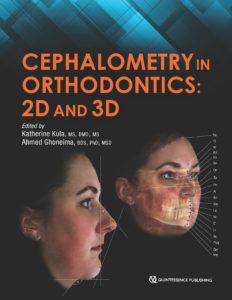 Cephalometry in Orthodontics: 2D and 3D
Cephalometry in Orthodontics: 2D and 3D
Edited by Katherine Kula and Ahmed Ghoneima
Cephalometrics has been used for decades to diagnose orthodontic problems and evaluate treatment. However, the shift from 2D to 3D radiography has left some orthodontists unsure about how to use this method effectively. This book defines and depicts all cephalometric landmarks on a skull or spine in both 2D and 3D and then identifies them on radiographs. Each major cephalometric analysis is described in detail, and the linear or angular measures are shown pictorially for better understanding. Because many orthodontists pick specific measures from various cephalometric analyses to formulate their own analysis, these measures are organized relative to the skeletal or dental structure and then compared or contrasted relative to diagnosis, growth, and treatment. Cephalometric norms (eg, age, sex, ethnicity) are also discussed relative to treatment and esthetics. The final chapter shows the application of these measures to clinical cases to teach clinicians and students how to use them effectively. As radiology transitions from 2D to 3D, it is important to evaluate the efficacy and cost-effectiveness of each in diagnosis and treatment, and this book outlines all of the relevant concerns for daily practice.
208 pp; 338 illus; ©2018; ISBN 978-0-86715-762-8 (B7628); Now available! $118
Read more about Cephalometry in Orthodontics: 2D and 3D here!
Edited by Andreas Filippi and Irène Hitz Lindenmüller
As the largest organ in the oral cavity, the tongue not only plays a primary role in masticatory and speech function—it is also a significant indicator of health, demonstrating signs of both oral pathologies and diseases that can affect the entire body. Because no health care provider gets the opportunity to examine a patient’s tongue as often as the dentist, it is essential for dentists to recognize when there may be a problem with the tongue and what the problem is. In addition to an overview of tongue anatomy and general diagnosis and treatment recommendations, this book contains an atlas of more than 50 specific diseases and health concerns that may present signs and symptoms in the tongue. Each is outlined in a quick-reference table describing etiology, prognosis, and more and is accompanied by photographs of different ways the condition can present. A true diagnostic aid, this guide will allow clinicians to identify and address any abnormality a patient’s tongue may exhibit.
216 pp; 591 illus; ©2019; ISBN 978-0-86715-776-5 (B7765); $148 Special preorder price! $118
Available November 2018
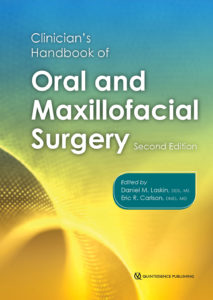 Clinician’s Handbook of Oral and Maxillofacial Surgery, Second Edition
Clinician’s Handbook of Oral and Maxillofacial Surgery, Second Edition
Edited by Daniel M. Laskin and Eric R. Carlson
There are frequent situations in which oral and maxillofacial surgeons find themselves in need of an immediate answer to a clinical problem. However, this can involve a time-consuming search for the appropriate reference source. This book continues the format of the previous edition by providing a single place to quickly find information on a diverse range of clinical topics, including dentoalveolar surgery, maxillofacial trauma, craniofacial anomalies, and oral pathology. All of the previous chapters have been updated, and new chapters on implantology, cleft lip and palate, maxillofacial reconstruction, oral squamous cell carcinoma, and cosmetic surgery have been added. Moreover, increasing the size of the book has allowed for the inclusion of many summary charts, tables, clinical photographs, and radiographs, which was not possible in the previous version. As a result, this new edition provides expanded information in an improved format.
Although this book is designed as a quick reference source, familiarizing oneself with its content in advance will both add to the reader’s general knowledge base and improve the ability to find information quickly in urgent situations. Residents in oral and maxillofacial surgery should find its content particularly useful during their clinical training, and the concise organization of the material should also be helpful to them in retaining information when subsequently preparing for the American Board of Oral and Maxillofacial Surgery.
624 pp (softcover); 374 illus; ©2019; ISBN 978-0-86715-730-7 (B7307); $168 Special preorder price! $134
Available November 2018
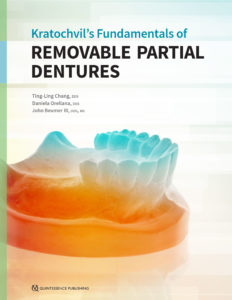 Kratochvil’s Fundamentals of Removable Partial Dentures
Kratochvil’s Fundamentals of Removable Partial Dentures
Ting-Ling Chang, Daniela Orellana, and John Beumer III
In the 1960s, Professor F. J. Kratochvil recognized the importance of biomechanics in removable partial denture (RPD) design and used these principles to develop a new design philosophy. This “RPI system”—a clasp assembly consisting of a rest, a proximal plate, and an I-bar retainer—changed how clinicians approach partial denture design and is now used throughout the world. This textbook provides an overview of Kratochvil’s design philosophy and the basic principles of biomechanics it is based upon. Topics include components of RPDs and their functions, design sequences for maxillary and mandibular RPDs, and techniques for surveying and determining the most advantageous treatment position. A chapter dedicated to digital design and manufacturing of RPD frameworks highlights new technology in this emerging field. Additional topics include optimizing esthetic outcomes through attachments and rotational path RPDs as well as applying the RPI system to patients with maxillofacial defects. The authors provide illustrations of clinical cases throughout the book as well as an illustrated glossary of prosthodontic terminology. This textbook will prepare students and general practitioners to design and fabricate a biomechanically sound RPD framework for just about any dental configuration they encounter.
240 pp; 748 illus; ©2019; ISBN 978-0-86715-790-1 (B7901); $108 Special preorder price! $86
Available November 2018
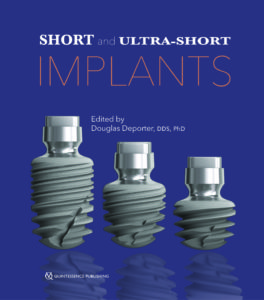 Short and Ultra-Short Implants
Short and Ultra-Short Implants
Edited by Douglas Deporter
Research has shown that short implants are not only a viable option but oftentimes a superior one that carries fewer risks for the patient and dentist, especially in resorbed jaw sites. As clinical trials continue to underscore the safety and efficacy of short implants, more dentists are considering their use with real interest, and this book provides the information clinicians need to incorporate short implants into their own practice. The book reviews the clinical effectiveness of short implants and then describes treatment protocols for the various types of short implants and their placement in different areas of the mouth. Case presentations demonstrate the recommended techniques and showcase the results.
168 pp; 334 illus; ©2018; ISBN 978-0-86715-785-7 (B7857); Now available! $85
Read more about Short and Ultra-Short Implants here!
The Time for Short Is Now: Today’s Short Implants and Why You Should Give Them a Chance
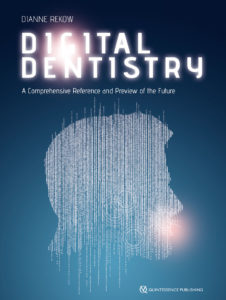 Digital Dentistry: A Comprehensive Reference and Preview of the Future
Digital Dentistry: A Comprehensive Reference and Preview of the Future
Dianne Rekow
This comprehensive reference book aims to describe and demystify the underlying principles of digital technologies. Contributions from authors with differing expertise emphasize the influence of digital technologies across a breadth of disciplines and review how we can acquire, manipulate, and leverage digital data within those disciplines. Also examined are the similarities and differences between available and emerging systems, the value and use of digital approaches to clinical cases, and the challenges and opportunities intrinsic to both integrating new technologies into dental practice and keeping up with rapid changes. Previewing the future, this resource explores the potential impact of new innovations on how and what we practice, as well as how we think, teach, and pursue knowledge. Energizing our ingenuity and imagination, this book lays the groundwork for dentistry’s vibrant and exciting future.
400 pp; 447 illus; ©2018; ISBN 978-1-78698-023-6 (BL081); $218
Arun K. Garg
Since the discovery of platelet-rich plasma (PRP) 25 years ago, interest in the use of autologous blood concentrates as adjuncts to surgical treatment has exploded. As more and more medically useful components of autologous blood concentrates have been identified, a host of unique acronyms such as PRF, CGF, PRGF, and more have surfaced, resulting in significant confusion among clinicians as to which material to use and when. Written by one of the original co-discoverers of PRP, this book tackles this issue of “too much information” by illuminating the science behind the clinical use of autologous blood concentrates as adjuncts to surgical treatment and helps to establish a foundation of practical knowledge for clinical use. The first part of the book summarizes the current literature from all aspects of medicine currently using autologous blood concentrates, showing both the possible applications as well as the limitations of these biologic materials. The second part of the book provides step-by-step instructions and richly illustrated treatment protocols for a number of applications for autologous blood concentrates specific to the practice of implantology and oral and maxillofacial surgery. Comprehensively researched and expertly written, this book is a must for clinicians who are just beginning to incorporate autologous blood concentrate treatment into their practice as well as experienced practitioners.
224 pp; 398 illus; ©2018; ISBN 978-0-99918-832-3 (B0007); $199
Read more about Autologous Blood Concentrates here!
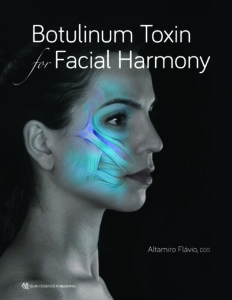 Botulinum Toxin for Facial Harmony
Botulinum Toxin for Facial Harmony
Altamiro Flávio
The mastery of dentistry brings esthetic knowledge of the face that is applicable to more than just the teeth. In the process of performing a complete facial analysis, the practitioner can identify asymmetries and concerns localized to an area—such as the forehead, eyebrows, nose, or lower face—and offer Botox therapy to increase facial harmony. This book outlines the many clinical uses for Botox, with detailed illustrations and case presentations to support each procedure. The first part of the book covers systematic facial analysis, photographic documentation, and how to plan treatment. Special attention is paid to the anatomy and physiology of the face and the identification of injection points. Detailed treatment instructions for dosage, syringe type, and needle size are included for each procedure, as well as guidelines on how to evaluate results anthropometrically to determine whether esthetic treatment goals have been met. This stunning book will change the way you approach facial analysis and widen your esthetic treatment options for patients.
160 pp; 359 illus; ©2018; ISBN 978-0-86715-787-1 (B7871); $148
Read more about Botulinum Toxin for Facial Harmony here!
Botulinum Toxin for Facial Harmony: How this Unconventional Treatment Can Expand Your Practice
Ralf J. Radlanski
Knowledge of the structures of the orofacial region from the macroscopic scale to the molecular level and pathologic changes to those structures enables practitioners to successfully treat patients or seek treatment options. This book presents the structural biologic foundations underpinning dental and oral medicine. Beginning with an overview of the anatomy of the mouth and moving on to the evolution of the oral structures and pre- and postnatal development of the oral cavity, related facial structures, and the teeth, this book describes each part of the orofacial region in terms of its morphology, tissue structure, cellular properties, and development. Functioning as both a textbook for dental students and a reference manual for experienced clinicians, this compendium of the structural biologic foundations of clinical work in dental and oral medicine allows practitioners to integrate current research in molecular biology into a solid framework of knowledge.
472 pp (softcover); 245 illus; ©2018; ISBN 978-0-86715-746-8 (B7468); $168
Sandra Tai
Clear aligners are the future of orthodontics, but digital orthodontics evolves so rapidly that it is hard to keep pace. This book approaches clear aligner treatment from a diagnosis and treatment-planning perspective, discussing time-tested orthodontic principles like biomechanics and anchorage and demonstrating how to apply them to orthodontic cases using these appliances. Each chapter explains how to use clear aligners to treat a given malocclusion and teaches clinicians how to program a suitable treatment plan using available software, how to design the digital tooth movements to match the treatment goals, and finally how execute the treatment clinically and finish the case well. This clinical handbook will prepare orthodontists and dental students to exceed patient expectations with the most esthetic orthodontic appliance currently available.
320 pp; 1,344 illus; ©2018; ISBN 978-0-86715-777-2 (B7772); $218
Read more about Clear Aligner Technique here!
Clear Aligner Technique: Bringing Orthodontic Treatment into the Digital Era
Current Issues in Journals
Featured article: Immediate Postextraction Screw-Retained Partial and Full-Arch Rehabilitation: A 3-Year Follow-up Retrospective Clinical Study
Roberto Villa, Gabriele Villa, and Massimo Del Fabbro
A Histologic and Histomorphometric Retrospective Analysis of the Outcomes of Ridge Preservation Using Anorganic Bovine Bone Minerals and a Nonresorbable Membrane
Seiko Min, Marcelo Freire, Neema Bakshallian, Ivy Wu, and Homayoun H. Zadeh
Three-Year Results of a Randomized Controlled Clinical Trial Using Submucosally Veneered and Unveneered Zirconia Abutments Supporting All-Ceramic Single-Implant Crowns
Barbara Eisner, Nadja Naenni, Jürg Hüsler, Christoph Hämmerle, Daniel Thoma, and Irena Sailer
Passivity of Fit of a Novel Prefabricated Implant-Supported Mandibular Full-Arch Reconstruction: A Comparative In Vitro Study
Matthias Karl, Roberto Carretta, and Kenji W. Higuchi
Clinical Fit of Monolithic Zirconia Single Crowns
Stefanie Anke Rau, Michael Raedel, Aikaterini Mikeli, Martina Raedel, and Michael H. Walter
THEMATIC ABSTRACT REVIEW: Use of Oral Implants for Cancer Reconstruction: The Role of the Approach to Vascular Flaps in Implant Outcomes
Martin Osswald
A Novel Experimental Dental Implant Permits Quantitative Grading of Surface-Property Effects on Osseointegration
Ernst B. Hunziker, Michael Spiegl-Habegger, Stefanie Rudolf, Yuelian Liu, Zhiyuan Gu, Kurt Lippuner, Nahoko Shintani, and Lukas Enggist
Systematic Review and Meta-Analysis of Hard Tissue Outcomes of Alveolar Ridge Preservation
Seyed Hossein Bassir, Muhanad Alhareky, Buddhathida Wangsrimongkol, Yinan Jia, MS, and Nadeem Karimbux
Editorial: A Parting Perspective of the Journal’s Evolution
Barry J. Sessle
Peripheral Glial Cell Line–Derived Neurotrophic Factor Facilitates the Functional Recovery of Mechanical Nociception Following Inferior Alveolar Nerve Transection in Rats
Masahiro Watanabe, Masamichi Shinoda, Dulguun Batbold, Naoyuki Sugano, Shuichi Sato, and Koichi Iwata
Analgesic Effects of Intranasal Ketamine in Rat Models of Facial Pain
Rafaela Claudino, Carina Nones, Erika Araya, and Juliana Chichorro
Short clinical screening procedure for initial diagnosis of temporomandibular disorders
Georg Meyer
Multidisciplinary treatment-increase of vertical dimension combined with Invisalign treatment
Beatriz Solano Mendoza, Lorena Gómez García, Hourieh Pourhamid, and Enrique Solano
Correcting severe deep bite with the Invisalign appliance
Bärbl Reistenhofer, Fanny Triessnig, and Katharina Besser
Dental Meetings Quintessence Will Attend in October
AAOMS 100th Annual Meeting: Booth #414
hosted by the American Association of Oral and Maxillofacial Surgeons, October 11–13 in Chicago, Illinois
The USC International Restorative Dentistry Symposium
hosted by the Herman Ostrow School of Dentistry of USC, October 12–13 in Los Angeles, California
ADA 2018: Booth #704
hosted by the American Dental Association, October 18–22 in Honolulu, Hawaii
SCAD 2018 Annual Conference
hosted by the Society for Color and Appearance in Dentistry, October 19–20 in Newport Beach, California
AAMP 65th Annual Meeting
hosted by the American Academy of Maxillofacial Prosthetics, October 26–30 in Baltimore, Maryland
AAP 2018 Annual Meeting: Booth #1506
hosted by the American Academy of Periodontology, October 27–30 in Vancouver, Canada
ACP 2018 Annual Session: Booth #1506
hosted by the American College of Prosthodontists, October 31–November 3 in Baltimore, Maryland
Upcoming Quintessence Events

